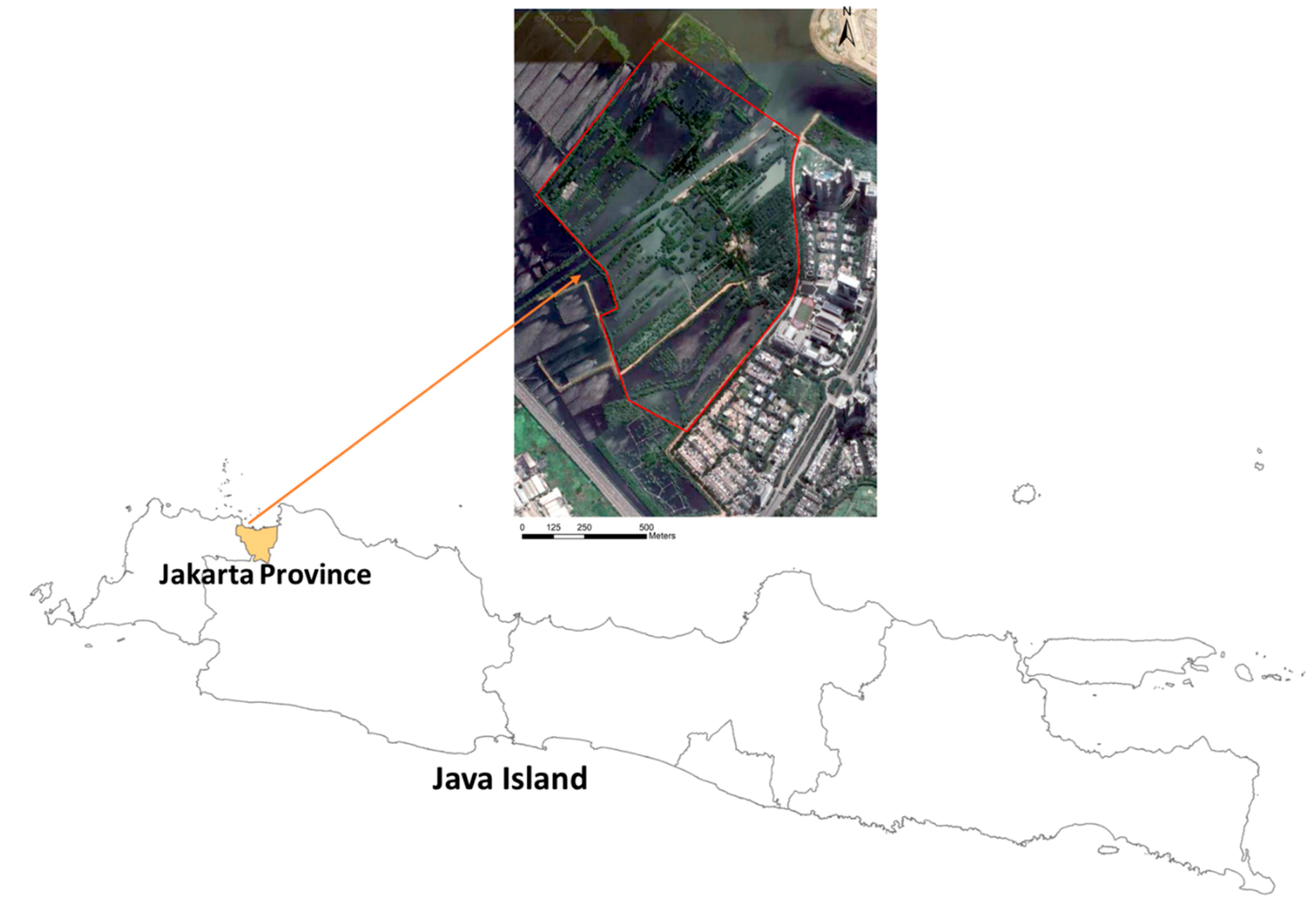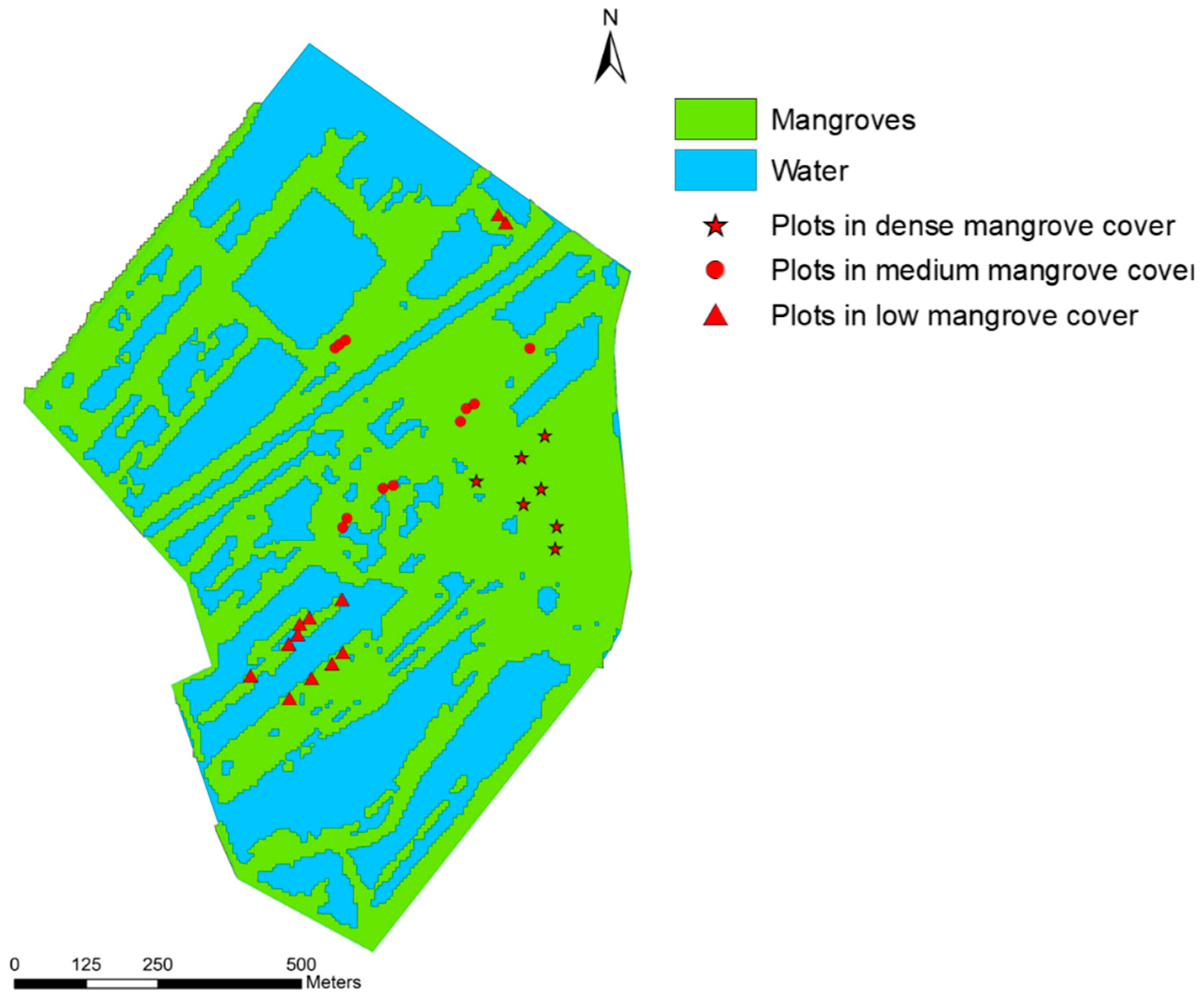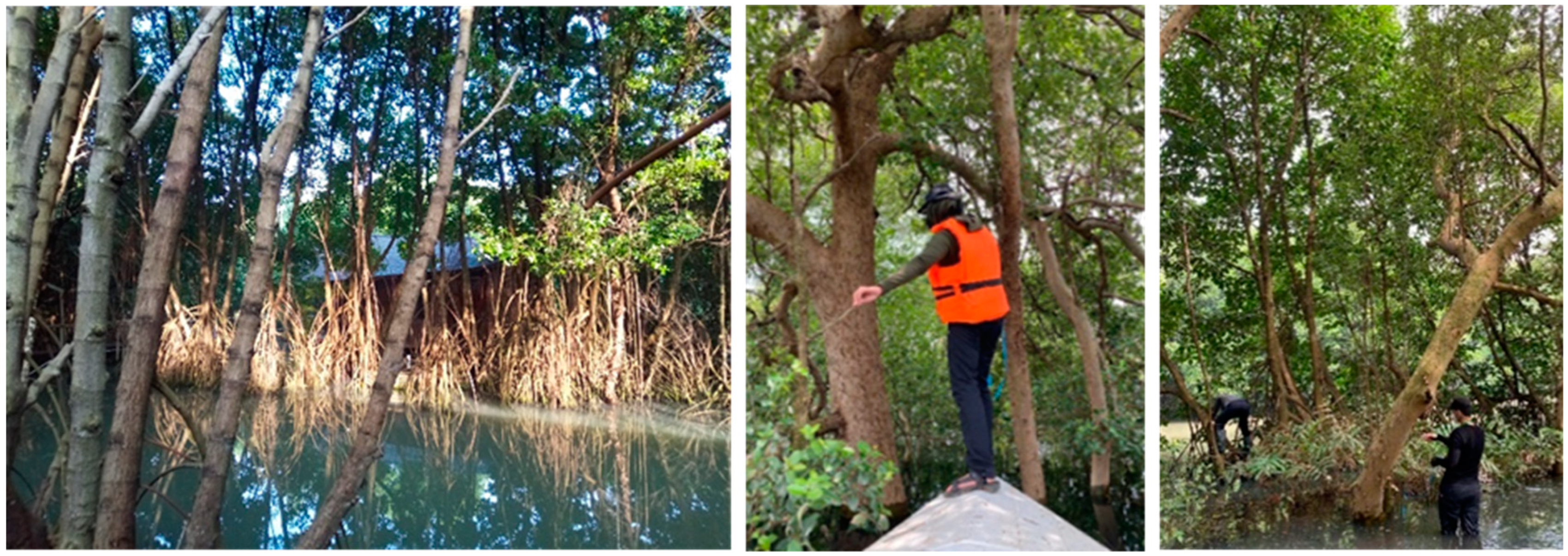Quantification of Ecosystem Services from Urban Mangrove Forest: A Case Study in Angke Kapuk Jakarta
Abstract
:1. Introduction
2. Materials and Methods
2.1. Study Area
2.2. Data Collection and Analysis
2.2.1. Carbon Storage
2.2.2. Absorption of Air Pollutants
2.2.3. Microclimate Regulation
- THI = Temperature–Humidity Index.
- T = Average daily air temperature (°C).
- RH = Average daily relative air humidity (%).
2.2.4. Nature Recreation
3. Results and Discussion
3.1. Carbon Storage
3.2. Absorption of Air Pollutants
3.3. Microclimate Regulation
3.4. Nature Recreation
3.5. Implication for Urban Mangrove Forest Management
4. Conclusions
Author Contributions
Funding
Data Availability Statement
Acknowledgments
Conflicts of Interest
References
- Cargiulo, C.; Battarra, R.; Tremiterra, M.R. Coastal areas and climate change: A decision support tool for implementing adaptation measures. Land Use Policy 2020, 91, 104413. [Google Scholar] [CrossRef]
- Wu, T. Quantifying coastal flood vulnerability for climate adaptation policy using principal component analysis. Ecol. Indic. 2021, 129, 108006. [Google Scholar] [CrossRef]
- Hakim, W.L.; Achmad, A.R.; Lee, C.W. Land subsidence susceptibility mapping in jakarta using functional and meta-ensemble machine learning algorithm based on time-series InSAR data. Remote Sens. 2020, 12, 3627. [Google Scholar] [CrossRef]
- Widada, S.; Zainuri, M.; Yulianto, G.; Satriadi, A.; Wijaya, Y.J. Estimation of Land Subsidence Using Sentinel Image Analysis and Its Relation to Subsurface Lithology Based on Resistivity Data in the Coastal Area of Semarang City, Indonesia. J. Ecol. Eng. 2020, 21, 47–56. [Google Scholar] [CrossRef]
- Sari, M.M.; Inoue, T.; Harryes, R.K.; Suryawan, I.W.K.; Yokata, K.; Notodarmojo, S.; Priyambada, I.B. Potential of Recycle Marine Debris in Pluit Emplacement, Jakarta to Achieve Sustainable Reduction of Marine Waste Generation. Int. J. Sustain. Dev. Plan. 2022, 17, 119–125. [Google Scholar] [CrossRef]
- Widyarani; Wulan, D.R.; Hamidah, U.; Komarulzaman, A.; Rosmalina, R.; Sintawardani, N. Domestic wastewater in Indonesia: Generation, characteristics and treatment. Environ. Sci. Pollut. Res. 2022, 29, 32397–32414. [Google Scholar] [CrossRef] [PubMed]
- Syuhada, G.; Akbar, A.; Hardiawan, D.; Pun, V.; Darmawan, A.; Heryati, S.H.A.; Siregar, A.Y.M.; Kusuma, R.R.; Driejana, R.; Ingole, V.; et al. Impacts of Air Pollution on Health and Cost of Illness in Jakarta, Indonesia. Int. J. Environ. Res. Public Health 2023, 20, 2916. [Google Scholar] [CrossRef]
- Alemu, J.B.; Richards, D.R.; Gaw, L.Y.F.; Masoudi, M.; Nathan, Y.; Friess, D.A. Identifying spatial patterns and interactions among multiple ecosystem services in an urban mangrove landscape. Ecol. Indic. 2021, 121, 107042. [Google Scholar] [CrossRef]
- Barbierato, E.; Bernetti, I.; Capecchi, I.; Saragosa, C. Integrating Remote Sensing and Street View Images to Quantify Urban Forest Ecosystem Services. Remote Sens. 2020, 12, 329. [Google Scholar] [CrossRef]
- Nyelele, C.; Kroll, C.N. The equity of urban forest ecosystem services and benefits in the Bronx, NY. Urban For. Urban Green. 2020, 53, 126723. [Google Scholar] [CrossRef]
- Wubbelt, A.G.; Fricke, A.; Sebesvari, Z.; Yakouchenkova, I.A.; Fröhlich, K.; Saha, S. High public appreciation for the cultural ecosystem services of urban and peri urban forests during the COVID-19 pandemic. Sustain. Cities Soc. 2021, 74, 103240. [Google Scholar] [CrossRef]
- Getzner, M.; Islam, M.S. Ecosystem Services of Mangrove Forests: Results of a Meta-Analysis of Economic Values. Int. J. Environ. Res. Public Health 2020, 17, 5830. [Google Scholar] [CrossRef] [PubMed]
- Whidayanti, E.; Handayani, T.; Supriatna; Manessa, M.D.M. A spatial study of mangrove ecosystems for abrasion prevention using remote sensing technology in the coastal area of Pandeglang Regency. IOP Conf. Ser. Earth Environ. Sci. 2021, 771, 012014. [Google Scholar] [CrossRef]
- Das, S. Ecological Restoration and Livelihood: Contribution of Planted Mangroves as Nursery and Habitat for Artisanal and Commercial Fishery. World Dev. 2017, 94, 492–502. [Google Scholar] [CrossRef]
- Su, J.; Friess, D.A.; Gasparatos, A. A meta-analysis of the ecological and economic outcomes of mangrove restoration. Nat. Commun. 2021, 12, 5050. [Google Scholar] [CrossRef] [PubMed]
- Arifanti, V.B.; Novita, N.; Sabarno; Tosiani, A. Mangrove deforestation and CO2 emissions in Indonesia. IOP Conf. Ser. Earth Environ. Sci. 2021, 874, 012006. [Google Scholar] [CrossRef]
- Ilman, M.; Dargusch, P.; Dart, P. A historical analysis of the drivers of loss and degradation of Indonesia’s mangroves. Land Use Policy 2016, 54, 448–459. [Google Scholar] [CrossRef]
- Sui, L.; Wang, J.; Yang, X.; Wang, Z. Spatial-Temporal Characteristics of Coastline Changes in Indonesia from 1990 to 2018. Sustainability 2020, 12, 3242. [Google Scholar] [CrossRef]
- Sumarga, E.; Syamsudin, T.S.; Rahman, S.P.; Putri, A.R.K.; Velia; Aldi, A.A.; Basyuni, M. Maintaining Carbon Storage Does Not Reduce Fish Production from Mangrove-Fish Pond System: A Case Study in Coastal Area of Subang District, West Java, Indonesia. Forests 2022, 13, 1308. [Google Scholar] [CrossRef]
- Noe, R.R.; Keeler, B.L.; Kilgore, M.A.; Taff, S.J.; Polasky, S. Mainstreaming ecosystem services in state-level conservation planning: Progress and future needs. Ecol. Soc. 2017, 22, 4. [Google Scholar] [CrossRef]
- Li, S.; Yu, D.; Huang, T.; Hao, R. Identifying priority conservation areas based on comprehensive consideration of biodiversity and ecosystem services in the Three-River Headwaters Region, China. J. Clean. Prod. 2022, 359, 13208. [Google Scholar] [CrossRef]
- Wang, T.; Chen, X.; Zheng, X.; Lu, Y.; Han, F.; Yang, Z. Identification of Priority Conservation Areas for Natural Heritage Sites Integrating Landscape Ecological Risks and Ecosystem Services: A Case Study in the Bogda, China. Int. J. Environ. Res. Public Health 2022, 19, 2044. [Google Scholar] [CrossRef]
- Ruslan, N.F.N.; Goh, H.C.; Hattam, C.; Edwards-Jones, A.; Moh, H.H. Mangrove ecosystem services: Contribution to the well-being of the coastal communities in Klang Islands. Mar. Policy 2022, 144, 105222. [Google Scholar] [CrossRef]
- Agustriani, F.; Iskandar, I.; Yazid, M.; Fauziyah. Economic Valuation of Mangrove Ecosystem Services in Sembilang National Park of South Sumatra, Indonesia. J. Hunan Univ. Nat. Sci. 2023, 50, 156–166. [Google Scholar] [CrossRef]
- O’Brien, L.E.; Urbanek, R.E.; Gregory, J.D. Ecological functions and human benefits of urban forests. Urban For. Urban Green. 2022, 75, 127707. [Google Scholar] [CrossRef]
- Intan, D.Z.; Yuniati, R.; Lestari, R. Comparative study on Pb absorption ability of five shade plant species in industrial estate and urban forests of Bekasi, Indonesia. Biodiversitas 2023, 24, 1289–1294. [Google Scholar]
- Lin, C.Y.; Fu, C.Y.; Liu, Y.; Zhang, M.Q.; Liu, Y.; Wu, W.Y.; Wang, L.X.; Lin, X.H.; Fu, X.M. Assessing the changes of the monetary value of mangrove ecosystem services in China and its application. Front. Environ. Sci. 2022, 10, 1018801. [Google Scholar] [CrossRef]
- Pertiwi, N.; Tsusaka, T.W.; Nguyen, T.P.L.; Abe, I.; Sasaki, N. Nature-based Carbon Pricing of Full Ecosystem Services for Peatland Conservation—A Case Study in Riau Province, Indonesia. Nat. Based Solut. 2022, 2, 100023. [Google Scholar] [CrossRef]
- Sun, C.; Wu, J.; Tang, H.; Yang, P. An urban hierarchy-based approach integrating ecosystem services into multiscale sustainable land use planning: The case of China. Resour. Conserv. Recycl. 2022, 178, 106097. [Google Scholar] [CrossRef]
- Rusolono, T.; Tiryana, T.; Purwanto, J. Guidance for Carbon Storage and Biodiversity Survey in South Sumatera; Biodiversity and Climate Change Project; German International Cooperation-GIZ: Bonn, Germany; South Sumatera Forestry Agency: South Sumatera, Indonesia, 2015. [Google Scholar]
- Aalde, H.; Gonzalez, P.; Gytarsky, M.; Krug, T.; Kurz, W.A.; Ogle, S.; Raison, J.; Schoene, D.; Ravindranath, N.H.; Elhassan, N.G.; et al. Chapter 4: Forest land. 2006 IPCC Guidelines for National Greenhouse Gas Inventories. 2006. Available online: https://www.ipcc-nggip.iges.or.jp/public/2006gl/pdf/4_Volume4/V4_04_Ch4_Forest_Land.pdf (accessed on 30 August 2022).
- Komiyama, A.; Poungparn, S.; Kato, S. Common allometric equation for estimating the tree wight of mangroves. J. Trop. Ecol. 2005, 21, 471–477. [Google Scholar] [CrossRef]
- Ong, J.E.; Gong, W.K.; Wong, C.H. Allometry and partitioning of the mangrove, Rhizophora apiculata. For. Ecol. Manag. 2004, 188, 395–408. [Google Scholar] [CrossRef]
- Dharmawan, I.W.S. Estimation of above ground biomass of Rhizophora mucronata in Ciasem, Purwakarta. J. Ilmu Pertan. Indones. 2010, 15, 50–56. [Google Scholar]
- Kusmana, C.; Hidayat, T.; Tiryana, T.; Rusdiana, O. Allometric models for above-and below-ground biomass of Sonneratia spp. Glob. Ecol. Conserv. 2018, 15, e00417. [Google Scholar] [CrossRef]
- Talan, M.A. Allometric Equation for Estimating above Ground Biomass of Xylocarpus granatum in Natural Mangrove Forest in Batu Ampar-West Kalimantan. Bachelor’s Thesis, Faculty of Forestry, Bogor Agricultural University, Dramaga, Indonesia, 2008. [Google Scholar]
- Nowak, D.J.; Hirabayashi, S.; Kroll, C.N. i-Tree Eco Dry Deposition Model Descriptions; Syracuse: New York, NY, USA, 2015. [Google Scholar]
- Numbeo. Pollution Index by City 2022. Available online: https://www.numbeo.com/pollution/rankings.jsp?title=2022 (accessed on 31 May 2022).
- World Population Review. World City Populations 2023. Available online: https://worldpopulationreview.com/world-cities (accessed on 2 August 2023).
- Nieuwolt, S.; Mc Gregor, G.R. Tropical Climatology, An Introduction to the Climates of the Low Latitude; John Wiley and Sons: New York, NY, USA, 1998. [Google Scholar]
- Hidayah, Z.; Rachman, H.A.; As-Syakur, A.R. Mapping of mangrove forest and carbon stock estimation of east coast Surabaya, Indonesia. Biodiversitas 2022, 23, 4826–4837. [Google Scholar] [CrossRef]
- Basyuni, M.; Wirasatriya, A.; Iryanthony, S.B.; Amelia, R.; Slamet, B.; Sulistiyono, N.; Pribadi, R.; Sumarga, E.; Eddy, S.; Al Mustaniroh, S.S.; et al. Aboveground biomass and carbon stock estimation using UAV photogrammetry in Indonesian mangroves and other competing land uses. Ecol. Inform. 2023, 77, 102227. [Google Scholar] [CrossRef]
- Wicaksono, P.; Danoedoro, P.; Hartono; Nehren, U. Mangrove biomass carbon stock mapping of the Karimunjawa Islands using multispectral remote sensing. Int. J. Remote Sens. 2016, 37, 26–52. [Google Scholar] [CrossRef]
- Alongi, D.M. Carbon sequestration in mangrove forests. Carbon Manag. 2014, 3, 313–322. [Google Scholar] [CrossRef]
- Murdiyarso, D.; Purbopuspito, J.; Kauffman, J.; Warren, M.W.; Sasmito, S.D.; Donato, D.C.; Manuri, S.; Krisnawati, H.; Taberima, S.; Kurnianto, S. The potential of Indonesian mangrove forests for global climate change mitigation. Nat. Clim. Chang. 2015, 5, 1089–1092. [Google Scholar] [CrossRef]
- Hamzeh, M.A.; Lahijani, H.A.K. Soil and Vegetative Carbon Sequestration in Khuran Estuary Mangroves, Strait of Hormoz, During the Last 18 Centuries. Estuaries Coasts 2022, 45, 1583–1595. [Google Scholar] [CrossRef]
- Turyanti, A.; Salmayenti, R.; Rohmawati, F.Y.; Fauziyah, N.; Yulian, N.I. Final Report on Air Quality Monitoring in Jakarta 2022; Life Environment Office of Jakarta: Jakarta, Indonesia, 2022. [Google Scholar]
- Hein, L.; Spadaro, J.V.; Ostro, B.; Hammer, M.; Sumarga, E.; Salmayenti, R.; Boer, R.; Tata, H.; Atmoko, D.; Castañeda, J.P. The health impacts of Indonesian peatland fires. Environ. Health 2022, 21, 62. [Google Scholar] [CrossRef] [PubMed]
- Rashidi, R.; Khaniabadi, Y.O.; Sicard, P.; Demarco, A.; Anbari, K. Ambient PM2.5 and O3 pollution and health impacts in Iranian megacity. Stoch. Environ. Res. Risk Assess. 2023, 37, 175–184. [Google Scholar] [CrossRef] [PubMed]
- Chen, X.; Zhao, P.; Hu, Y.; Ouyang, L.; Zhu, L.; Ni, G. Canopy transpiration and its cooling effect of three urban tree species in a subtropical city- Guangzhou, China. Urban For. Urban Green. 2019, 43, 126368. [Google Scholar] [CrossRef]
- Rana, G.; Ferrara, R.M. Air cooling by tree transpiration: A case study of Olea europaea, Citrus sinensis and Pinus pinea in Mediterranean town. Urban Clim. 2019, 29, 100507. [Google Scholar] [CrossRef]
- Rahman, M.A.; Moser, A.; Rötzer, T.; Pauleit, S. Comparing the transpirational and shading effects of two contrasting urban tree species. Urban Ecosyst. 2019, 22, 683–697. [Google Scholar] [CrossRef]
- de Frenne, P.; Zellweger, F.; Rodríguez-Sánchez, F.; Scheffers, B.; Hylander, K.; Luoto, M.; Vellend, M.; Verheyen, K.; Lenoir, J.R.M.H. Global buffering of temperatures under forest canopies. Nat. Ecol. Evol. 2019, 3, 744–749. [Google Scholar] [CrossRef] [PubMed]
- Sayer, J. Rainforest Buffer Zones: Guidelines for Protected Area Managers; IUCN: Gland, Switzerland, 1991. [Google Scholar]
- Sumarga, E.; Suwandhi, I.; Haitaunnisa; Nurahman, A.Y.; Susilowardani, D.; Shadida, A. Disturbances-based plan of delineating protected area’s buffer zone: A case study in Masigit Kareumbi Mountain, West Java, Indonesia. Biodiversitas 2021, 22, 5115–5122. [Google Scholar] [CrossRef]
- Indonesian Ministry of Environment and Forestry. Operational Plan Indonesia’s Folu Net Sink 2030. 2022. Available online: https://www.menlhk.go.id/site/single_post/4705/operational-plan-indonesia-s-folu-net-sink-2030 (accessed on 29 June 2023).
- Gehrels, L.; Garrett, E. Rising sea levels as an indicator of global change. In Climate Change: Observed Impacts on Planet Earth; Letcher, T.M., Ed.; Elsevier: Amsterdam, The Netherlands; Oxford, UK; Cambridge, MA, USA, 2021. [Google Scholar]
- Bott, L.M.; Schöne, T.; Illigner, J.; Haghighi, M.H.; Gisevius, K.; Braun, B. Land subsidence in Jakarta and Semarang Bay—The relationship between physical processes, risk perception, and household adaptation. Ocean Coast. Manag. 2021, 211, 105775. [Google Scholar] [CrossRef]



| Mangrove Species | Allometric Equations | Sources |
|---|---|---|
| Avicennia marina | Komiyama et al. [32] | |
| Rhizophora apiculata | Ong et al. [33] | |
| Rhizophora mucronata | Dharmawan [34] | |
| Sonneratia spp. | Kusmana et al. [35] | |
| Xylocarpus granatum | Talan et al. [36] |
| Mangrove Species | Allometric Equations | Sources |
|---|---|---|
| Avicennia marina | Komiyama et al. [32] | |
| Rhizophora apiculata | Ong et al. [33] | |
| Rhizophora mucronata | Komiyama et al. [32] | |
| Sonneratia spp. | Kusmana et al. [35] | |
| Xylocarpus granatum | Komiyama et al. [32] |
| No | Comfort Classes | THI |
|---|---|---|
| 1 | Comfortable | 21–24 |
| 2 | Moderate | 25–26 |
| 3 | Uncomfortable | >26 |
| Mangrove Cover | Above-Ground Carbon (tonnes C/ha) | Below-Ground Carbon (tonnes C/ha) | Carbon in Deadwood (tonnes C/ha) | Carbon Storage 1 (tonnes C/ha) | Area (ha) | Carbon Total (tonnes) |
|---|---|---|---|---|---|---|
| Low | 54.3 | 13 | 1 | 68.3 | 22.8 | 1555.6 |
| Moderate | 96.6 | 23.3 | 0.3 | 120.2 | 20.9 | 2511.6 |
| Dense | 114.1 | 53.6 | 4.7 | 172.4 | 13.3 | 2289.1 |
| Total | 57 | 6356.3 | ||||
| Average | 83.7 | 26.3 | 1.6 | 111.6 |
| No | Pollutants | Absorption by Mangrove (kg/Year) |
|---|---|---|
| 1 | CO | 209.4 |
| 2 | O3 | 3768.8 |
| 3 | NO2 | 2470.8 |
| 4 | SO2 | 704.1 |
| 5 | PM10 | 3773.6 |
| 6 | PM2.5 | 373.7 |
| Total | 11,300.4 |
| No | Species | Number of Trees | Absorption of Pollutant (ton/Year) |
|---|---|---|---|
| 1 | Avicennia marina | 30,384 | 3.4 |
| 2 | Rhizophora apiculata | 1518 | 0.1 |
| 3 | Rhizophora mucronata | 52,757 | 7.7 |
| 4 | Sonneratia caseolaris | 379 | 0.07 |
| 5 | Xylocarpus granatum | 190 | 0.01 |
| Total | 85,228 | 11.3 |
| Location | Mean and Standard Deviation of Daily Air Temperature (°C) | Mean and Standard Deviation of Daily Relative Air Humidity (%) | Mean and Standard Deviation of Daily THI | ||||||
|---|---|---|---|---|---|---|---|---|---|
| Inside Mangrove Park | 50 m from Mangrove Park | 300 m from Mangrove Park | Inside Mangrove Park | 50 m from Mangrove Park | 300 m from Mangrove Park | Inside Mangrove Park | 50 m from Mangrove Park | 300 m from Mangrove Park | |
| 1 | 30.05 ± 0.42 | 31.41 ± 1.46 | 31.55 ± 1.41 | 72.56 ± 2.09 | 68.26 ± 6.81 | 65.09 ± 6.25 | 28.40 ± 0.41 | 29.40 ± 0.97 | 29.33 ± 1.02 |
| 2 | 30.17 ± 0.78 | 31.25 ± 1.39 | 31.54 ± 1.44 | 71.95 ± 2.78 | 67.07 ± 6.31 | 65.77 ± 4.92 | 28.48 ± 0.71 | 29.18 ± 1.05 | 29.37 ± 1.07 |
| 3 | 30.01 ± 0.68 | 31.42 ± 1.59 | 31.57 ± 1.6 | 73.76 ± 3.44 | 68.65 ± 7.95 | 64.96 ± 5.9 | 28.44 ± 0.55 | 29.43 ± 1.01 | 29.35 ± 1.13 |
| 4 | 30.24 ± 1.01 | 31.79 ± 1.5 | 31.6 ± 1.74 | 73.99 ± 3.28 | 66.63 ± 6.47 | 65.13 ± 7.09 | 28.67 ± 0.86 | 29.65 ± 0.98 | 29.37 ± 1.16 |
| 5 | 29.93 ± 0.86 | 31.01 ± 0.9 | 31.36 ± 1.41 | 74.33 ± 2.96 | 67.81 ± 6.56 | 65.33 ± 6.7 | 28.39 ± 0.78 | 29.01 ± 0.5 | 29.17 ± 0.89 |
| Mean | 30.08 ± 0.72 | 31.38 ± 1.3 | 31.52 ± 1.4 | 73.32 ± 2.84 | 67.68 ± 6.29 | 65.26 ± 5.68 | 28.47 ± 0.63 | 29.33 ± 0.87 | 29.32 ± 0.97 |
| Year | Number of Visitors |
|---|---|
| 2018 | 256,693 |
| 2019 | 169,530 |
| 2020 | 78,400 |
| 2021 | 87,852 |
| 2022 | 100,276 |
Disclaimer/Publisher’s Note: The statements, opinions and data contained in all publications are solely those of the individual author(s) and contributor(s) and not of MDPI and/or the editor(s). MDPI and/or the editor(s) disclaim responsibility for any injury to people or property resulting from any ideas, methods, instructions or products referred to in the content. |
© 2023 by the authors. Licensee MDPI, Basel, Switzerland. This article is an open access article distributed under the terms and conditions of the Creative Commons Attribution (CC BY) license (https://creativecommons.org/licenses/by/4.0/).
Share and Cite
Sumarga, E.; Sholihah, A.; Srigati, F.A.E.; Nabila, S.; Azzahra, P.R.; Rabbani, N.P. Quantification of Ecosystem Services from Urban Mangrove Forest: A Case Study in Angke Kapuk Jakarta. Forests 2023, 14, 1796. https://doi.org/10.3390/f14091796
Sumarga E, Sholihah A, Srigati FAE, Nabila S, Azzahra PR, Rabbani NP. Quantification of Ecosystem Services from Urban Mangrove Forest: A Case Study in Angke Kapuk Jakarta. Forests. 2023; 14(9):1796. https://doi.org/10.3390/f14091796
Chicago/Turabian StyleSumarga, Elham, Arni Sholihah, Febby Angelina Edi Srigati, Servina Nabila, Puteri Raysa Azzahra, and Naufal Pasya Rabbani. 2023. "Quantification of Ecosystem Services from Urban Mangrove Forest: A Case Study in Angke Kapuk Jakarta" Forests 14, no. 9: 1796. https://doi.org/10.3390/f14091796
APA StyleSumarga, E., Sholihah, A., Srigati, F. A. E., Nabila, S., Azzahra, P. R., & Rabbani, N. P. (2023). Quantification of Ecosystem Services from Urban Mangrove Forest: A Case Study in Angke Kapuk Jakarta. Forests, 14(9), 1796. https://doi.org/10.3390/f14091796






